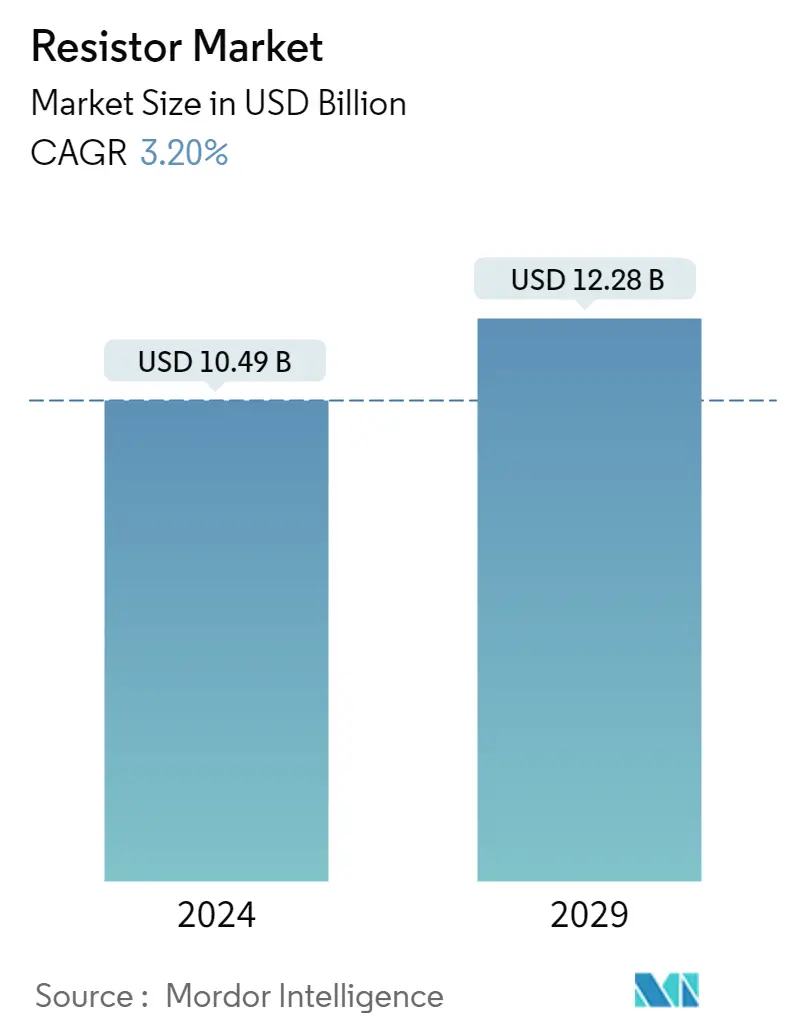Market Size of Resistor Industry

| Study Period | 2019 - 2029 |
| Market Size (2024) | USD 10.49 Billion |
| Market Size (2029) | USD 12.28 Billion |
| CAGR (2024 - 2029) | 3.20 % |
| Fastest Growing Market | Asia Pacific |
| Largest Market | Asia Pacific |
Major Players
*Disclaimer: Major Players sorted in no particular order |
Resistor Market Analysis
The Resistor Market size is estimated at USD 10.49 billion in 2024, and is expected to reach USD 12.28 billion by 2029, growing at a CAGR of 3.20% during the forecast period (2024-2029).
- Automotive manufacturers are consistently working towards enhancing performance while reducing cost and mass, leading to significant advancements in electrical and electronic components used in automobiles. Despite the emergence of digital technology, the reliability and accuracy of many circuits still rely on their analog components.
- In the automotive sector, rising functionality is resulting in a greater number of motors and ECUs, and at the same time, the mounting area for applications is limited. As a result, high-density mounting increases, spurring the demand for components, including compact power shunt resistors. Further, the applications of high-performance bus bar shunt resistors in electric vehicles are helping designers meet the challenges of the market in new and innovative ways. The increase in demand for EVs has been complementing the demand for resistors in the market.
- Power resistors are designed to withstand large amounts of power and dissipate unwanted electrical energy with a compact device footprint. This is essential in aircraft, where space and weight capacity are crucial factors. They are poised to be essential in developing next-generation fly-by-wire (FBW) flight control systems that seek to replace manual flight controls with fully electronic equivalents. Further research into power-by-wire technology also uses power resistors to replace heavyweight hydro-mechanical flight control systems with electric actuators driven by digital flight control computers.
- Resistors are being used in almost all defense platforms, and the defense industry prefers the use of nickel-chromium in film, wire, and foil formats due to its resistance to moisture and operational reliability.
- Furthermore, ruthenium has experienced a significant price increase in the last few years, from USD 40 per troy ounce to as high as USD 850 per troy ounce, corresponding with shortages of thick film chip resistors. This price increase has resulted in customers seeking alternative resistor designs, including those based on thin-film nickel. However, the economies of scale in manufacturing thin-film resistors are a small fraction compared to thick-film chips. Thick film chips are one of the largest volume products produced globally, measured in trillions of pieces.
- Moreover, The COVID-19 pandemic had an impact on the sales of semiconductor materials. However, in Post-pandemic scenario, there has been a growing demand for consumer electronics products, which has helped the semiconductor industry to expand. As a result, there is projected to be an increase in product demand in the automotive and electronics sectors, which will contribute to the growth of the resistor market and enhance overall efficiency.
Resistor Industry Segmentation
A resistor is a passive electronic component that helps control the flow of electrical current in an electronic circuit. It is commonly utilized in various ways, such as reducing current flow, adjusting signal levels, dividing voltages, biasing active elements, and terminating transmission lines.
The resistor market is segmented by type (surface-mounted chips, network, wirewound, film/oxide/foil, and carbon), by end-user industry (automotive, aerospace and defense, communications, consumer electronics and computing, and other end-user industries), by geography (North America, Europe, Asia-Pacific, Rest of the World). The market sizes and forecasts are provided in terms of value (USD million) for all the above segments.
| Type | |
| Surface-mounted Chips | |
| Network | |
| Wirewound | |
| Film/Oxide/Foil | |
| Carbon |
| End-User Industry | |
| Automotive | |
| Aerospace and Defense | |
| Communications | |
| Consumer Electronics and Computing | |
| Other End-user Industries (Medical, Industrial, Energy and Power) |
| Geography | |
| North America | |
| Europe | |
| Asia-Pacific | |
| Rest of the World (Latin America, Middle East & Africa) |
Resistor Market Size Summary
The resistor market is poised for steady growth, driven by advancements in automotive and consumer electronics sectors. As automotive manufacturers strive to enhance performance while minimizing costs and weight, the demand for compact and efficient electronic components, including resistors, is on the rise. The increasing functionality in vehicles, particularly with the surge in electric vehicles, necessitates the use of high-density mounting components like power shunt resistors. Similarly, the electronics industry, with its continuous push for more efficient and compact devices, is seeing a growing demand for various types of resistors, such as surface-mount chip resistors and varistors, which are essential for protecting sensitive electronic equipment from voltage spikes. The market is also experiencing a shift towards alternative resistor designs due to material cost fluctuations, prompting innovation and adaptation in resistor manufacturing.
The Asia-Pacific region is becoming a focal point for resistor manufacturing, with multinational corporations establishing production facilities to cater to the burgeoning electronics market. China's strategic initiatives to bolster its electronic components industry further underscore the region's significance. The demand for resistors is particularly strong in consumer electronics, driven by the need for components in smartphones, laptops, and gaming devices. Despite challenges such as the COVID-19 pandemic's impact on semiconductor sales, the market is rebounding with increased demand in automotive and electronics sectors. The resistor market remains competitive, with key players engaging in product development and strategic partnerships to expand their global footprint and meet the evolving needs of various industries.
Resistor Market Size - Table of Contents
-
1. MARKET DYNAMICS
-
1.1 Market Overview
-
1.2 Market Drivers
-
1.2.1 Increasing Demand from the Automotive Industry
-
1.2.2 Growing Demand for High-performance Electronics
-
-
1.3 Market Restraints
-
1.3.1 Growth in the Metal Prices to Impact Production Cost
-
-
1.4 Value Chain Analysis
-
1.5 Industry Attractiveness - Porter's Five Forces Analysis
-
1.5.1 Bargaining Power of Buyers
-
1.5.2 Bargaining Power of Suppliers
-
1.5.3 Threat of New Entrants
-
1.5.4 Threat of Substitute Products
-
1.5.5 Intensity of Competitive Rivalry
-
-
1.6 Macro-economic Analysis
-
-
2. MARKET SEGMENTATION
-
2.1 Type
-
2.1.1 Surface-mounted Chips
-
2.1.2 Network
-
2.1.3 Wirewound
-
2.1.4 Film/Oxide/Foil
-
2.1.5 Carbon
-
-
2.2 End-User Industry
-
2.2.1 Automotive
-
2.2.2 Aerospace and Defense
-
2.2.3 Communications
-
2.2.4 Consumer Electronics and Computing
-
2.2.5 Other End-user Industries (Medical, Industrial, Energy and Power)
-
-
2.3 Geography
-
2.3.1 North America
-
2.3.2 Europe
-
2.3.3 Asia-Pacific
-
2.3.4 Rest of the World (Latin America, Middle East & Africa)
-
-
Resistor Market Size FAQs
How big is the Resistor Market?
The Resistor Market size is expected to reach USD 10.49 billion in 2024 and grow at a CAGR of 3.20% to reach USD 12.28 billion by 2029.
What is the current Resistor Market size?
In 2024, the Resistor Market size is expected to reach USD 10.49 billion.

